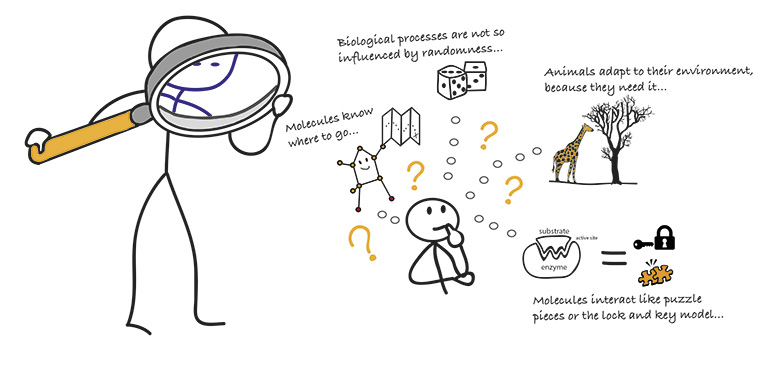More concepts, fewer facts
ETH biology lecturers have tested secondary school leavers and students to determine their knowledge of biological concepts. And they have drawn some sobering conclusions: many misunderstand the concepts, such as the importance of chance in biology. Now, the lecturers are taking action.
In biology lessons, pupils learn a great deal of factual knowledge, but the underlying biological concepts of evolution, genetics and molecular interrelations are often forgotten or treated as marginal subjects. Secondary school pupils and students therefore often misunderstand these concepts – if they understand them at all – and it takes a great deal of effort and expense to correct these misconceptions at a later stage. These are the findings of a group of ETH researchers from the Institute of Molecular Systems Biology, who recently published a study in the journal PLOS One.
Targeted testing of conceptual knowledge
Annie Queloz Champagne, a biology doctoral student, used a special questionnaire to test the conceptual knowledge of 475 secondary school pupils before their Matura (school-leaving examination). The pupils had to answer 24 questions, relating primarily to concepts of evolution and genetics and the properties and functions of molecules. A multiple-choice format allowed them to choose the most appropriate answer. The same questionnaire had been used in an earlier study to test students in the first and third semesters of their biology studies at ETH and the University of Zurich. The researchers were thus able to compare the knowledge of the different groups directly. The survey of pupils before they sit their Matura gives the ETH lecturers a headstart, as they are able to adapt their teaching in the undergraduate biology courses before the students arrive.
Clear deficiencies in conceptual knowledge
The current study of secondary school pupils now makes it clear that their conceptual knowledge is inadequate. And this knowledge grows by a maximum of just 20 percent in the first semesters of the biology studies compared with their knowledge at the time of the Matura. For Katja Köhler, co-author of the study and lecturer in biology at ETH Zurich, the conclusions are clear: “The growth in knowledge is shockingly small, but it is the most that can be achieved through traditional teaching – that is, lecture-style teaching as part of undergraduate studies.” She adds that this figure is not specific to ETH and is consistent with that of surveys by other universities and in the US.
For example, pupils find the concept of the random principle in biology particularly challenging. Teaching presents a picture of targeted processes and sequences that ignores the accidental nature of many events, such as interactions between molecules or evolutionary processes. “Many traditional textbooks present a deterministic picture of biology. This misleads students,” says Köhler.
Another problem area in biology teaching is that students are unable to apply concepts from other subjects, such as physics or chemistry, to the field of biology. Each subject is taught separately, with no reference to interconnections or applications in other fields.
General revision of lectures
The results of the first study with new entrants led to the decision about two years ago to change the style and content of teaching for biology students at ETH. “We too have often provided students with factual knowledge through lecture-style teaching,” says Köhler. “Since the first study, we have been working on a fundamental overhaul of the learning content in the first years of the biology courses with a focus more on the communication of biological concepts.”
Biology lecturers at ETH have therefore started to focus on the role of chance in their lectures. Katja Köhler points out: “We are increasingly developing our own teaching materials, which we use in addition to the traditional textbooks.”
Bridging the gap to physics
Physics lectures for incoming biology students have also been redesigned and now deal more intensively with topics related to biology. “The example of the apple that falls to the ground due to gravity has nothing to do with biology, even if an apple is present,” emphasises Köhler. In physics for biologists, the aim is to convey physics knowledge that is relevant to biology. In future, the plan is to extend this approach to other service lectures within the biology curriculum.
However, the mass lectures held for undergraduate students are a particular challenge to improved teaching. These lectures are attended by up to 600 students, sometimes from different fields of study. “With such a large number of students, with such heterogeneous prior knowledge, it is very difficult to meet everyone’s needs,” says Köhler, speaking from her own experience.
One solution is for biology lecturers to distribute preparatory documents to the students before the lecture. This allows the students to prepare themselves for the lecture and study part of the learning material independently and at their own pace. The lecturer can then focus their efforts on questions, discussions or practice exercises. This is intended to be a more efficient way of anchoring the biological concepts in students’ minds.
Regular knowledge inventory
The test used by the ETH researchers was developed a few years ago in the US as the Biological Concepts Instrument (BCI); this was the first time it had been used outside the US. The researchers will continue to use it to test students’ conceptual understanding in the first semesters of the biology studies. “For us, this questionnaire is a very valuable tool that allows us to establish a link between research and application. Lecturers can implement the results directly into their own degree programmes,” says Köhler.
Reference
Champagne Queloz A, Klymkowsky MW, Stern E, Hafen E, Köhler K. Diagnostic of students’ misconceptions using the Biological Concepts Instrument (BCI): A method for conducting an educational needs assessment. PLOS ONE 12(5) : e0176906 , external pagedoi: 10.1371/journal.pone.0176906call_made

